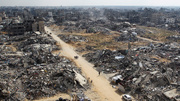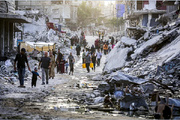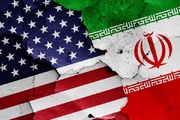Wetlands are essential for environmental health, ecological balance, water management, and climate resilience. They are among the most productive ecosystems, providing habitats for diverse plant and animal species, including many that are threatened or endangered.
When it comes to the importance of wetlands, Iran stands out as the country has enjoyed a landmark convention that was inked over five decades ago.
The Ramsar Convention, signed on February 1, 1971, is the first global treaty for wetland protection. It focuses on the conservation and sustainable use of wetlands, highlighting their ecological, economic, cultural, and recreational significance.
Wetlands support a wide range of biodiversity, and the Ramsar Convention safeguards the species and ecosystems reliant on these areas. They are also key in carbon sequestration, aiding climate change mitigation, and the convention advocates for the preservation of these ecosystems.
Furthermore, the convention emphasizes sustainable water resource management, recognizing wetlands' roles in purification, flood control, and hydrological cycles. It encourages collaboration among countries and stakeholders to address shared wetland challenges, promoting knowledge sharing and joint conservation efforts.
Additionally, the Ramsar Convention raises awareness about the importance of wetlands and fosters public engagement in conservation initiatives. Countries are urged to designate wetlands of international importance as Ramsar Sites for protection, thereby prioritizing conservation efforts and attracting funding for related projects.
The Convention is critical for safeguarding the world's wetlands, which are vital for biodiversity, water management, and overall planetary health.
What is the significance of Iran's Bandar Khamir?
Located in the southern Iranian province of Hormozgan, the wetland city of Bandar Khamir has earned a spot among 12 distinguished cities in UNESCO’s Global Network of Learning Cities, celebrated for its efforts in lifelong education and climate action, thus creating an opportunity for the region to attract nature lovers to Iran.
The recognition was announced in late September during the UNESCO event “Changing Minds: Promoting Sustainable Lifestyles and Reframing Human-Nature Relationships".
Bandar Khamir was praised in the online collection “Lifelong Learning for Climate Action,” alongside other cities namely Bogota (Colombia), Edmonton (Canada), Espoo (Finland), Uiwang (South Korea), Hamburg (Germany), Jubail Industrial City (Saudi Arabia), Marrakech (Morocco), N’Zerekore (Guinea), Okayama (Japan), Shanghai (China), and Wyndham (Australia).
Bandar Khamir won recognition as the city had effectively implemented educational initiatives aimed at sustainable development and local climate action.
The coastal city was previously introduced as one of the 12 cities recognized for their climate measures during the UNESCO World Conference on Education for Sustainable Development (ESD), which took place in Berlin, Germany in May 2021.

What is a learning city?
Cities differ in cultural and ethnic composition, heritage, and social structures. However, many characteristics of a learning city are common to all. Simply put, a learning city seeks to promote lifelong learning for all human beings.
How did The GNLC network begin?
Learning cities at all development stages can significantly benefit from exchanging ideas with one another, as solutions to emerging challenges may already exist elsewhere.
In 2013, the UNESCO Institute for Lifelong Learning established the UNESCO Global Network of Learning Cities (GNLC) to foster this idea exchange and provide cities with the necessary expertise, guidance, and support throughout their development.
This international, policy-oriented network serves as a source of inspiration, knowledge, and best practices for those involved in creating learning cities.
The GNLC effectively mobilizes resources across sectors to promote inclusive learning from basic to higher education, enhance learning in families and communities, facilitate workplace learning, utilize modern technologies, and encourage a lifelong learning culture.
By fostering lifelong learning for all, learning cities contribute to realizing the universal right to education, making their development highly appealing. Transitioning into a learning city is an ongoing process without a definitive endpoint; rather, it is recognized by specific attributes reflecting actions taken rather than mere identity.
The development of a learning city demands a practical, operational approach to implementing lifelong learning, supported by political will and a commitment to monitoring progress through key indicators.

How does a city become a member?
To become a network member, a municipality must pursue a vision of lifelong learning and embrace the values and objectives of UNESCO that promote dialogue and international cooperation. Learning cities also prioritize green and healthy environments, equity, inclusion, and support for decent work and entrepreneurship, thus playing a vital role in local sustainability in both urban and rural areas.
Bandar Khamir’s strategic approach to climate action
Bandar Khamir, a vibrant city on Iran's southern coast, boasts a rich cultural history and a unique coastal ecosystem. With a population of around 80,000, it experiences an arid climate characterized by hot summers and mild winters. Mangroves and wetlands are vital to the city's landscape, providing ecological benefits and serving as a habitat for diverse marine species. In light of the city’s vulnerability to natural disasters, such as floods, prioritizing climate resilience and sustainable development has become crucial.
The city’s primary goal is to enhance climate resilience by promoting the role of mangroves and wetlands in flood mitigation. Increasing public awareness about these ecosystems aims to foster responsibility for their conservation and restoration, directly contributing to the city’s climate mitigation goals.
To address global climate change and improve local air quality, the strategy emphasizes how mangroves capture carbon dioxide and release oxygen, thus acting as significant carbon sinks. This highlights Bandar Khamir's role in international climate change mitigation.
A key component of the plan is empowering residents to establish and maintain mangrove nurseries, nurture seedlings, and engage in planting projects along the coastline. Such involvement transforms locals into dedicated caretakers of their environment, encouraging sustainable use of the region’s wetland ecosystem.
Central to city policies is Education for Sustainable Development, fostering a culture of continual learning and responsible environmental management. Inclusive community-driven education campaigns provide residents with the knowledge and skills necessary for sustainable development through modern learning technologies. This approach, which prioritizes environmental sustainability, civic engagement, and resilience, equips residents to shape a more climate-resilient future.
A priority is also the creation of educational centers and interactive displays within the city to teach residents about the importance of mangroves and wetlands in a changing climate. This deeper understanding ensures that citizens remain informed and eco-conscious.
Lifelong learning is essential to Bandar Khamir's climate strategies. Continuous education on the significance of mangroves and wetlands helps residents adapt to climate change while contributing to conservation efforts. Promoting ongoing learning strengthens community engagement and collaboration, which is crucial to the city’s climate agenda.
Key stakeholders include local educational institutions, which are tasked with integrating climate education into curricula to raise awareness about the role of mangroves and wetlands in crisis mitigation. Additional courses and workshops encourage a continuous learning environment for climate action.
Youth and environmental NGOs, like ‘Bandar Khamir Nature Lovers’, lead workshops and campaigns to educate residents on the value of mangroves and wetlands while mobilizing volunteers for conservation projects.
The local government formulates policies that promote climate education and action by allocating resources for educational initiatives, supporting awareness campaigns, and coordinating efforts to protect wetlands and mangroves. Oversight is provided by the city’s Wetland and Learning Steering Committee, which includes representatives from various governmental departments.
By leveraging the strengths and commitments of each stakeholder group, Bandar Khamir seeks to create a strong collaborative framework to support its ambitious climate action and Education for Sustainable Development objectives.
Golden opportunity to enhance regional tourism
The southern Iranian port city has great potential to attract more tourists and enhance regional tourism. By promoting its cultural and natural assets, enhancing tourism infrastructure, and engaging potential visitors through targeted marketing, Bandar Khamir can become a vibrant tourist destination, benefiting the local economy and preserving culture. This is an excellent opportunity to showcase the region's unique offerings and attract a diverse range of tourists.
Organizing annual events like music festivals, art exhibitions, or food fairs that highlight local traditions can also help introduce this pristine region.
Reported by Tohid Mahmoudpour
























Your Comment